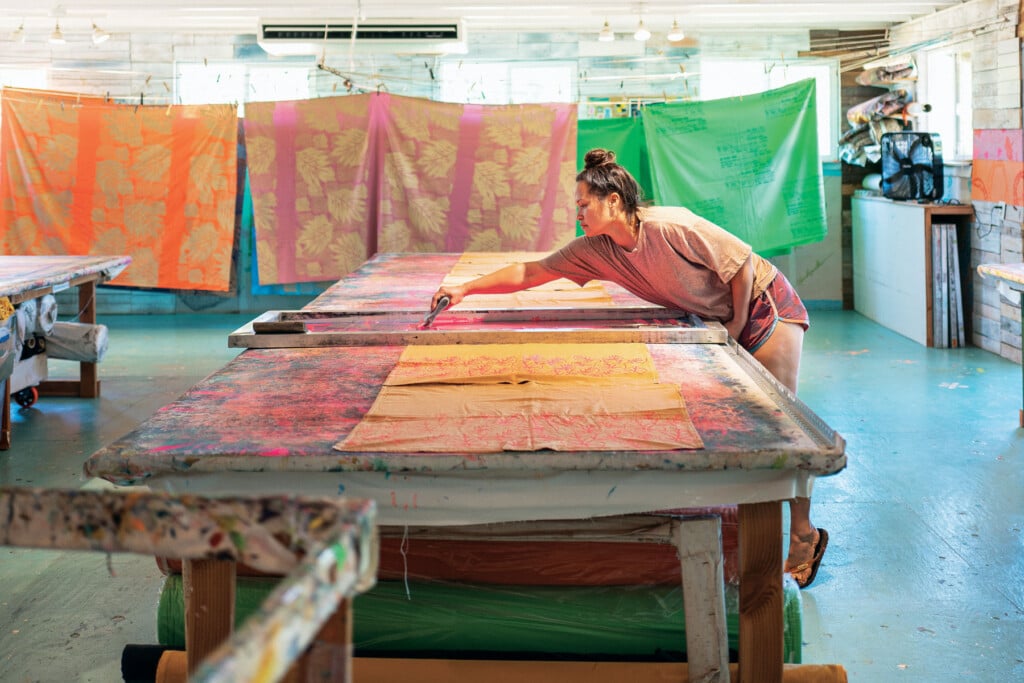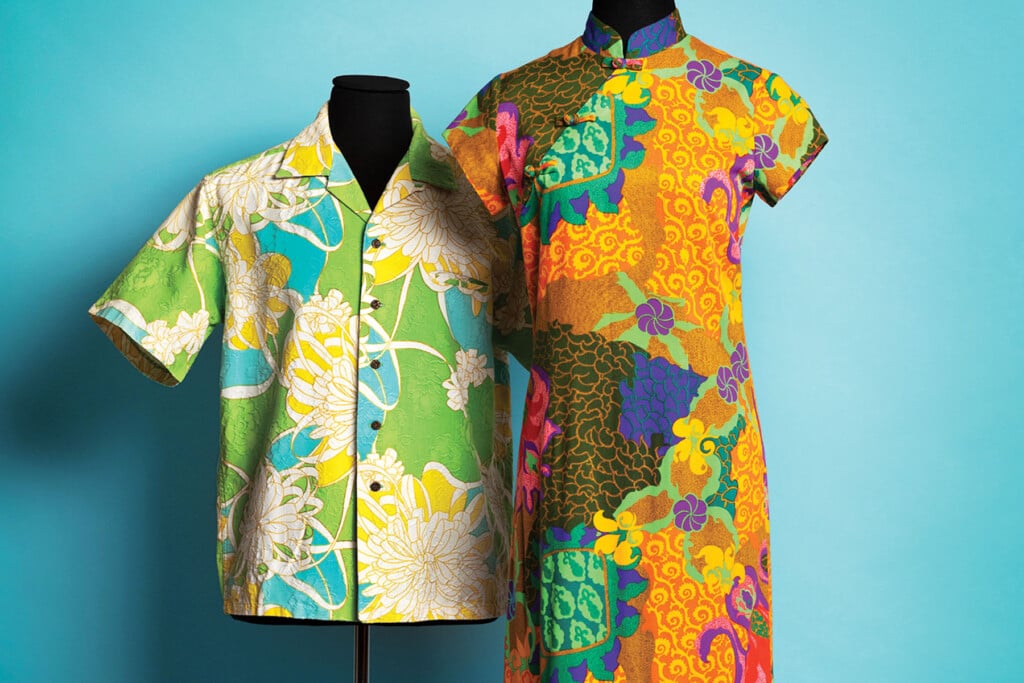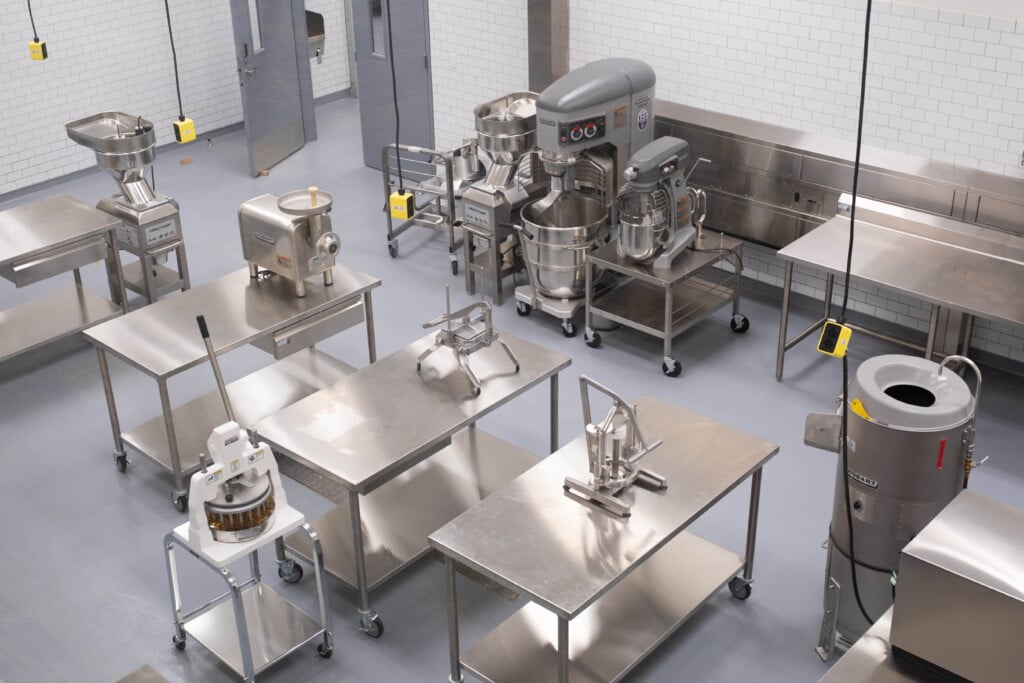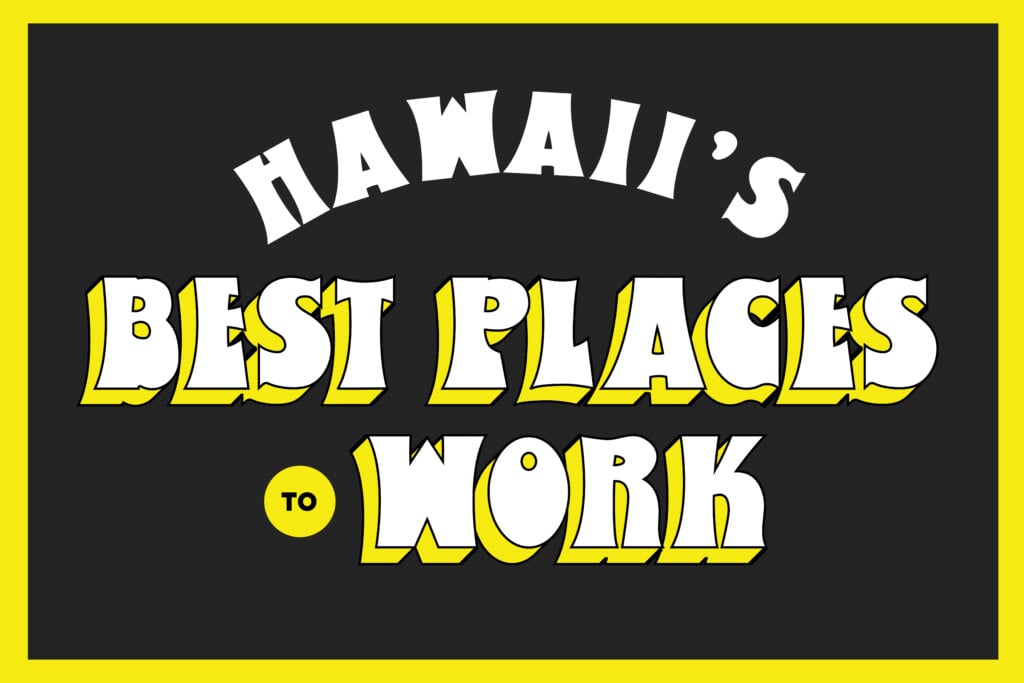Made in Hawaii
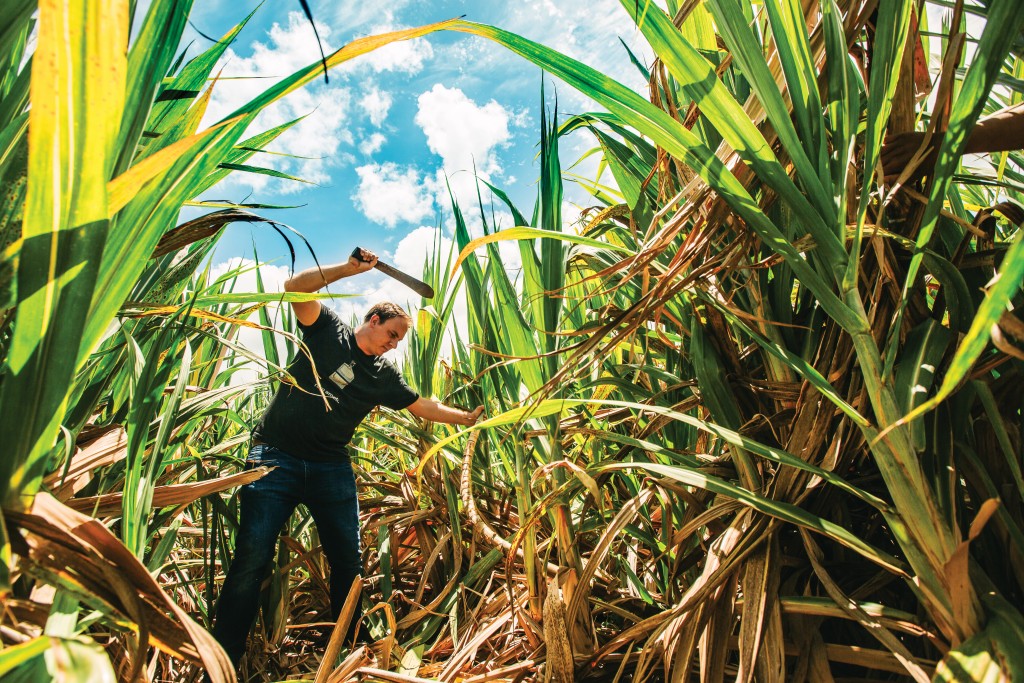
Iolani Sportswear president Lloyd Kawakami remembers when aloha shirts were only made in Hawaii. Today, they are produced cheaply in Asia or sold under labels such as Tommy Bahama, which have no connection to the Islands. That competition has put many local shirt makers out of business, but Kawakami didn’t change Iolani’s commitment to designing, cutting and sewing products locally. Instead, he revised his brand strategy 10 years ago.
“We took our 65-year history, our heritage and the proprietary things we owned, and used that to build our brand,” he says. “You’ve got so many competitors. The only way customers will buy your products is if they want the brand.”
“Hawaii is the center of our brand. That’s our pedigree. Our history. A guy from Ohio can’t make that claim.”
Business coach and author Mark Brigden says the best way for local companies like Iolani Sportswear to stand out among global competitors is to connect their brand identity to Hawaii. “There’s German efficiency and Swedish creativity. Hawaii, on the other hand, brings an emotive feeling of relaxation, enjoyment, well-being and being on Island time.”
Brigden singles out Na Hoku, the state’s oldest and largest jewelry manufacturer with stores around the U.S., as a company that successfully evokes the spirit of Hawaii through its imagery, in-store experience, website and products. Na Hoku’s president and CEO, Ed Sultan, agrees that a brand strategy based on the deep emotional connection people have to the Islands can be effective.
“Hawaii as a brand is huge,” Sultan says. “You say the word Hawaii to anybody outside of Hawaii, and they immediately warm up to you. Their natural resistance to protect themselves from strangers vanishes, and they let you into their world.”
Not everybody interprets the symbolism of Hawaii the same way, but every local business leader we talked with agreed it can be powerful if harnessed correctly. Here are their takes on the Made in Hawaii brand.
Commitment to Local
Promoting locally grown food is part of a personal commitment Derek Kurisu made to the late Tony Taniguchi, former CEO of KTA Super Stores.
“He told me that, when the plantations go under, it would be my obligation to help them,” says Kurisu, KTA’s executive VP. “Back then I didn’t think they would ever disappear. I grew up surrounded by sugar. It was such a big world. But, after Tony passed away, and each time another planation closed, I thought, I’ve got to do something to help local farmers.”
Kurisu started with milk. Back in 1992, cheaper milk imported from the Mainland had forced most local dairies to close. He gathered the few remaining dairy farmers together, defined the values they would stand for and put out a product with the story of local milk on the carton. Today, KTA’s Mountain Apple Brand features over 200 food products grown, processed or manufactured in state, including eggs, range-fed beef, Island lamb, bananas and ethnic foods such as poi, smoked fish and Japanese pickled cabbage.
Roy Yamaguchi, celebrity chef and founder of a collection of restaurants that feature Hawaii-inspired cuisine, has noticed dramatic changes the last few years in how people talk about food.
“Before, the conversations people were having here about food weren’t that deep. Today, locally grown has become part of people’s daily lingo,” Yamaguchi says.
Denise Yamaguchi, CEO of the Hawaii Food and Wine Festival, says the opportunities for Hawaii-branded food are enormous. She points to the explosion of poke restaurants opening across the Mainland, as well as the recent passing of legislation by the U.S. Senate designating the week of June 12 as National Hawaiian Foods Week.
“Way back, a tomato was just a tomato. Now you see branding by farmers to meet the demands for eating local. In the last five, 10 years in the farmers markets, you’ve started to see ‘Grown in Kunia’ and ‘Grown in Hoopili.’ That trend is catching on, and farmers are seeing the value in marketing their produce that way,” she says.
Large national and multinational companies are adjusting their strategies to offer more Made in Hawaii products. Whole Foods Market says it purchased nearly $12 million in products from local suppliers last year, adding 420 new local items to its three stores in Hawaii, and increasing signage to highlight the stories of these products.
Dabney Gough, metro marketing field team leader at Whole Foods, sees such interest as just the beginning. “Hawaii boasts not only an incredible diversity of agricultural products that cannot be grown on the Mainland, but the quality of our local coffee, bean-to-bar chocolate, and dried fruits and nuts – just to name a few – is simply unbeatable. The opportunities are ripe for additional Mainland and global expansion.”
Heritage and Authenticity
Kyle Reutner, brand manager of Ko Hana Rum, believes consumers are becoming savvier about a company’s authenticity. “Sure, it’s easy to wave your hands and write a Hawaiian word on a bottle. But when you look at any aspect of our process from farm to distillery to the tours we give, everything is 100 percent honest.”
To produce its rum, the company says, it grows 34 heirloom varietals of Hawaiian sugar cane. “We’re ridiculously dogmatic in what needs to be from here,” Reutner says, laughing. “I don’t even like sourcing from other islands, I like for it to all be from Oahu.”
Ko Hana Rum can’t afford to match the outreach of big rum makers and doesn’t try. “We’re never going to chase down Bacardi. Instead, we want to encourage people to find themselves in Kunia, in a place most don’t even know exists, and get steeped in the experience. Then the rum will speak for itself.”
Surfboards represent a different facet of what it means to be Made in Hawaii, because all their raw materials come from out of state: fiberglass and resin from Texas, epoxy from Ohio and blanks from California. At the Hawaii Surf Factory, what is homegrown is the craftmanship, says owner Pete Thorne.
“To develop the skills to work with materials, it takes years and years and years. One of our polishers is 65, and it’s all he’s done since he was 15. One of our shapers has been building surfboards since his teens. He turns 80 this year,” says Thorne.
Those decades of experience separate his products from what’s sold at Walmart. “Customers know they are going to get a hand-shaped surfboard, and that the shaper has gone over the shape with them and signed it. That’s a big deal for customers from Japan and Australia. When they get a board shaped by Dick Brewer, it’s like a guitarist getting the opportunity to sit down and play with Clapton.”
People Are the Brand
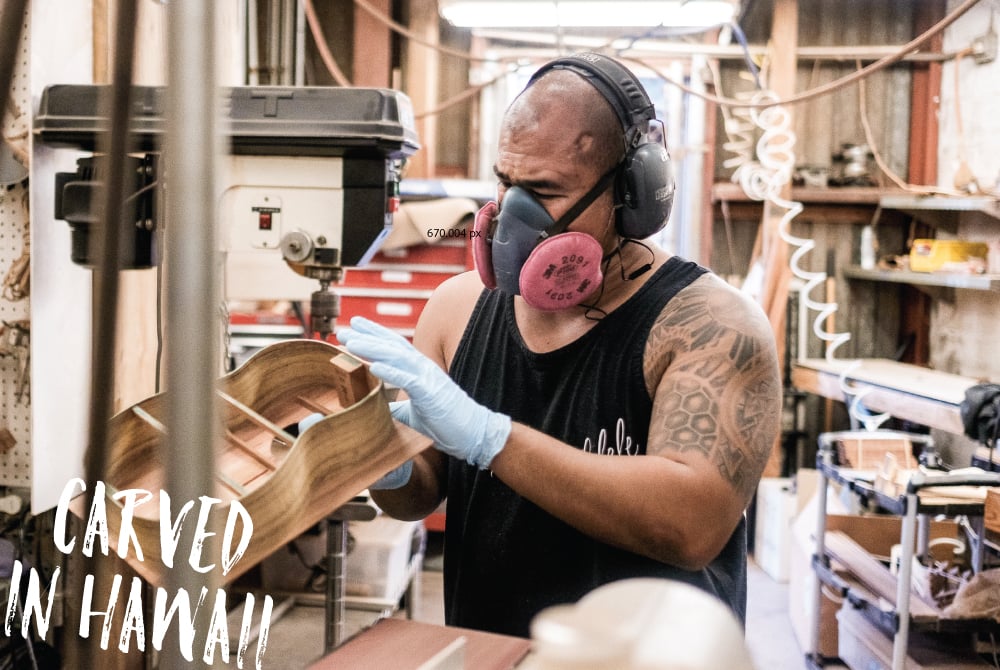
Craftsman Dennis Hermano builds an ukulele at KeAloha Ukulele. Owner Alan Okami says the company’s local values are an essential element of the instruments they produce. Aaron K. Yoshino
Though his ukuleles are regarded as among the finest in the world for their craftsmanship, KoAloha president Alan Okami emphasizes something less tangible.
“Sure, there’s the sticker that we can put on the product. But the way we think about Made in Hawaii is primarily about family, the relationships we maintain and also how we treat people. We’re all born and raised here. Each day at work, we eat together family style. Take breaks together to play darts or our version of hacky sack.”
“I think that’s all part of the Made in Hawaii flavor,” Okami says. “If I try to assign a way to describe it, it’s that each of these experiences and the way we get along, all factor into what we make.”
He extends these relationships to the connections he hopes people will have with his company’s ukuleles. “Customers have shared with us that they fell in love with our instruments, played them until they fell asleep, and woke up with the ukulele by their side. I could spend a bunch of money in advertising, but you can’t manufacture those kinds of moments,” says Okami.
The commitment to people is also at the heart of Ed Sultan’s way of defining what it means for a jewelry company to be in and of Hawaii. “When we decided to build the Na Hoku brand – we didn’t want to build a hollow Hawaiian brand, or one that only people outside of Hawaii know. We wanted it to be a true Hawaiian brand for local people,” he says.
That includes resisting the temptation to move production overseas. That commitment to employees, Sultan says, is just as central to Na Hoku’s identity as its products. “If I were to close a factory and make it all offshore, they would have to find something else to do. We want to keep our team employed and making a living and taking care of their families. We feel a big responsibility to do that.”
Quality First, Not Expansion
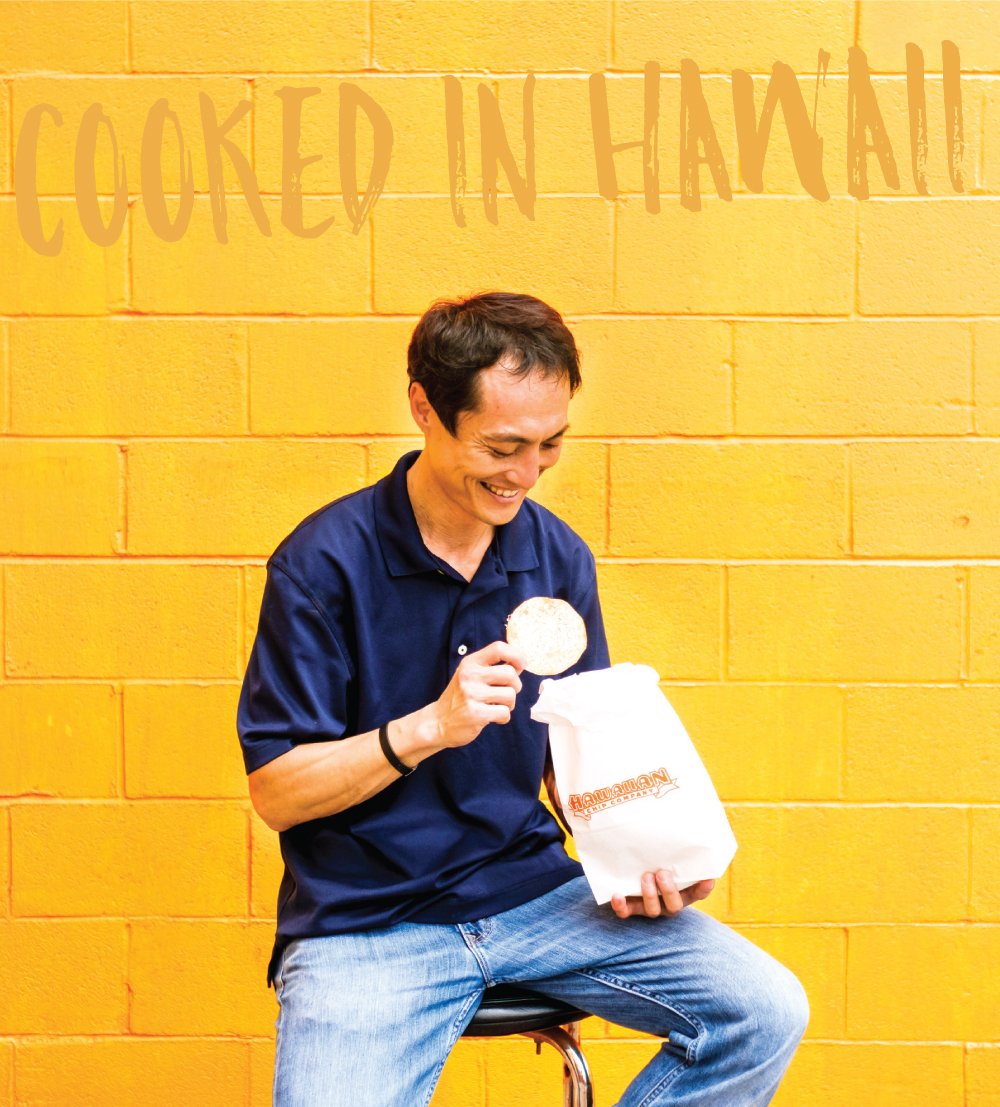
Jimmy Chan wants to preserve quality at Hawaiian Chip Co., so he has resisted the temptation to move production to the Mainland. Photo: Aaron K. Yoshino
Sixteen years ago, Jimmy Chan was watching Emeril make sweet potato chips on his cooking show when he craved something to go with his beer. Walking into the kitchen, he saw Okinawa sweet potatoes on the counter, decided to slice and fry them, and the rest is the history of Hawaiian Chip Co. Today, the company is known for its taro and sweet potato chips, made from products grown on the Big Island, Oahu’s North Shore and Molokai.
Despite the opportunities to expand by moving production to the Mainland, Chan is staying put. “My chips are specialty gourmet, almost like a craft item. Making them is a specialized process with a lot of people involved with every step. Outsourcing that to someone else on the Mainland would mean I’d have to move myself because I haven’t been able to find somebody to run the production line the way I want it done. Plus, I’d be so far away from those Molokai potatoes, making it harder to maintain quality.”
Chan cites Big Island Candies as the inspiration behind his business model. Instead of expanding its production elsewhere, the company kept it all in Hilo, limiting what is available in general stores while providing a wider range to specialty stores. “I’m a Hilo boy myself, and I see that their store has become a worldwide destination. Everyone leaves Hilo with a box of their stuff,” says Chan.
Big Island Candies director of retail operations Lance Duyao agrees the company’s success is based on a conscious decision to keep production in state. “One thing that kept us afloat and sustained us is that we are careful about our expansion. Quality is so important to us. We don’t want to spread ourselves thin by opening too many locations.”
As such, all of the shortbread, cookies and chocolates continue to be made only in Hilo. “Nothing is made anywhere else but here. And when people order stuff online and see that the box is actually postmarked in Hilo, there is an incredible value to that,” he says.
Multiple Touch Points
Many of the leaders of larger businesses insist the Hawaii brand be embodied in more than just the product being sold. It should be felt in all the little and big ways a company engages with its customers.
Hawaiian Airlines, for example, features local artists in its magazine and audio channels; its amenity kits are designed by local designers using exclusive patterns; and it features beer and spirits by Maui Brewing and Koloa Rum, plus dishes by local chefs in first class.
“We use all the senses: music, the smell of the soap, the kind of cuisine we serve. The aircraft is the stage, and we try to deliver a sensory experience of Hawaii,” says Avi Mannis, senior VP of global marketing. “We try to make every touch point with every guest meaningful and speak to Hawaii.”
Every detail at Aulani, a Disney Resort & Spa, reflects the same principle of creating a holistic Hawaiian experience for guests, says Elliot Mills, Disney VP of hotel operations for Disneyland Resort and Aulani.
“When Disney first started on this project, a committee made up of local cultural consultants was established to help guide Disney Imagineers to ensure every aspect of the resort was informed by the Hawaiian culture. You’ll see this come to life in everything from the kapa print on the linen, to the pewa joints embedded in the doors and headboards in our rooms, to the distinct halau waa shape of the buildings,” Mills says.
L&L Hawaiian Barbecue President and CEO Eddie Flores Jr. has adopted a similar strategy. Across his 200 franchise locations, products such as Kauai Kookies, King’s Hawaiian Sweet Bread, Hawaiian Sun drinks and even copies of the Honolulu Star Advertiser are available to transport people back to the Islands, even if just for a moment.
“We even get our lau lau shipped in from Hawaii,” Flores says. “We don’t make any money off of it, but it’s important because there’s no other place else they can find it. People will drive one or two hours just to eat the lau lau.”
Innovative Solutions
Beer and environmental sustainability are not two concepts that typically go together. But Kona Brewing Co. advisory board member and former president Mattson Davis says the company’s core values include a commitment to recycling, saving water and keeping coastlines beautiful.
He says a new 30,000-square-foot facility and high-efficiency brewery located in Kona will include the ability to recycle organic byproducts to create energy, equipment that will conserve grain and water, and a solar system that will supply 50 percent of its energy.
“We are moving toward zero impact on the environment. The technology has finally caught up with our vision for what’s right for Hawaii,” says Davis. “It’s not just a brand promise, it’s a brand purpose for the environment, water and community.”
Melialani James, head of new ventures for Sultan Ventures and program director for XLR8UH, says the Hawaii brand has potential beyond the traditional industries of food, drinks, ukuleles and surfboards. The state’s small but thriving startup scene, which has a strong focus on clean energy, aquaculture and sustainable practices, is also an important part of the Hawaii brand.
Silicon Valley has long dictated the startup lifestyle, but it can be reimagined through distinctly Hawaiian values. “Because of communication technologies, we can work from anywhere,” James says. “And if you can be working from anywhere, why not Hawaii? It’s about work hard and play hard, doing dawn patrol by 5 a.m., and being at the computer by 8 a.m. We are going to see people want to have that balance, have the best of all worlds.”
Protecting the Brand
The state Department of Agriculture protects the specific terms “Made in Hawaii,” “Produced in Hawaii” and “Processed in Hawaii.” Only products that have at least 51 percent of their manufacturing, assembly, fabrication or production costs originating in the state can use these terms on their products or in their advertising.
Nonetheless, the Hawaii brand is so powerful that companies with little or no connection to the state continue to use it. Hawaiian Punch and Hawaiian Sweet Maui Onion Potato Chips, for example, do not contain any ingredients that originate in the state. Global restaurant chain Trader Vic’s, which features the “Original Mai Tai,” has its roots in California. Perhaps most troubling is the use of Kona coffee on products with as little as 10 percent of its beans from the region.
“There’s no other place in the world that doesn’t protect its brand like Hawaii,” says state Sen. Russell Ruderman. “And we have a powerful brand name that has an image for the best quality. We should be protecting that. It’s worth money. If we dilute it or let anybody call anything Hawaiian, we’re going to lose the brand name.”
Ruderman is advocating for state laws that do not allow companies to use geographic names without following guidelines. “Most places in the world protect their geographic identity. You can’t call something Idaho potatoes if it’s not grown in Idaho. Hawaii doesn’t do that at all. You can say Hawaii mac nuts even if it’s not from here.”
State Department of Agriculture economic development specialist Sharon Hurd acknowledges that what the state can protect currently has its limits. A tea made in China and called Naalehu is not breaking any current laws because it does not specifically say made in Hawaii. Papayas grown in Hainan Province are currently being sold as Hawaiian in China, but the state has no legal recourse there. And, unfortunately, Hurd says, the department currently only has one employee to investigate all complaints, although it is planning to rebuild its staff.
“If Apple and Louis Vuitton can’t protect their brands globally, how can we?”
Despite the feeling that, for every falsely labeled product the Department of Agriculture identifies, many more are out there, Hurd emphasizes how important it is for consumers and businesses to not be complacent, and to file complaints when they see the Made in Hawaii brand being misused. (Call 832-0690 or mail your complaint to 1851 Auiki St., Honolulu, HI, 96819.)
In the end, she says, it is about retaining the high value that such a brand brings.
“Hawaii is more of a feeling than a place. By using ‘Made in Hawaii,’ you take somebody to that place rather than just to a particular product. It has enormous value. When you say something is Made in Hawaii, you get a piece of Hawaii.
You hear the waves. You get the dream.”
Made in Hawaii With Aloha

The state-managed Made in Hawaii with Aloha branding program was established to protect the integrity of authentic Hawaii products and distinguish them from products falsely labelled as being from Hawaii. Learn more, including how to participate, at hdoa.hawaii.gov/madewithaloha.
